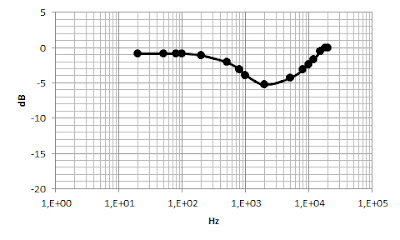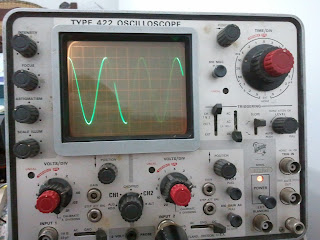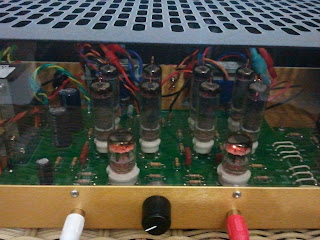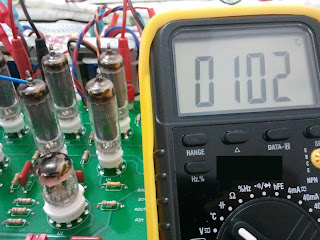After assembly the tube audio amplifier, I have got some measurements to plot the frequency response magnitude.
I have used a 8ohms purely restrictive load (figure below).
I swept the frequency of an sinusoid input signal from 20Hz to 20kHz. I took the outputs signals in an oscilloscope Tektronix Type 422.
Bass and treble adjust were on the maximum position.
Figure below shows the frequency response magnitude.
I haven't noted any distortion. Even in low frequencies, the output sinusoid is free of distortion.
Figures below shows outputs at 20Hz, 30Hz, 50Hz and 80Hz.
Following my propose (previously posted: tube amp improvements part 1):
1) Big output transformers (high inductance) provide a good response at low frequencies and without distortions.
2) I can't evaluate yet the benefits of bigger power source capacitors. I have not seen ripple at output. I can hear a humm noise but the circuit in not shielded yet. After I conclude the shield I will can evaluated the benefits of bigger capacitors.
3) I tried bigger coupling capacitors and also eliminated them in some connections, but I have not noted significant results for the bandwidth.
4) The next step will be: tests with output transformers at ultralinear configuration. I will connect the screen resistors to the specific wires of the output transformers primaries.
My first impressions: very good output transformers and tubes (Sylvania).
electronic components, circuits, devices, vacuum tubes, consumer electronics, audio, TVs, etc.
Wednesday, August 28, 2013
Monday, August 26, 2013
Tube amp improvements: output transformers (part 3)
Figures below show my two new output transformers (one per channel).
At the primary there are the wires for five connections: +B, two plates (push pull) and the two screens.
At the secondary there are wires for connections to speakers with 8ohms or 4ohms.
They were designed for 5000ohms plate-to-plate effective load resistance, 250VDC plate voltage (+B to plate) and 20Wrms.
The magnetization inductance need be sufficient to get a bandwidth from 20 to 20kHz. This inductance is parallel to the reflected load. Then, roughly, the cut-off frequency will be:
fc = R/(2*pi*L)
L = R/(2*pi*fc)
It can be seen that the size of the output transformer limits the low frequencies response. To get deep bass it is necessary high inductance:
L = 5000/(2*pi*20) = 40 H
Briefly, that is why I got big output transformers (40H!!!).
Firstly I will not use the screen grid connections. I will do some tests and get some measurements. After, I will connect the screen grids wires and compare the results.
Figures below shows the source power transformer. At the secondary there are connections to the filaments of the tubes (6.3V AC) and to the rectifier (about 200VAC).
Friday, August 23, 2013
Tube amp improvements: circuit board (part 2)
Here is the circuit board with components.
It can be seen the big power source capacitors. I used two 470uF capacitors to get the B+ and one more 220uF capacitor to the screen grids. After tests in this configuration I will connect the screen grid resistors on the specific windings of the output transformers (ultralinear configuration).
At the figure below it can be seen the blue and yellow colors of the Sylvania 6005 tubes with warmed filaments.
Next, I will connect the power transformer and output transformers.
At the figure below it can be seen the blue and yellow colors of the Sylvania 6005 tubes with warmed filaments.
Next, I will connect the power transformer and output transformers.
Thursday, August 22, 2013
Tube amp improvements (part 1)
I will try to improve the tube amp with 6005 tubes in a push-pull configuration and 5670 tubes to excite the grids.
I have noted that these tubes (6005 and 5670) provides a good trade-off solution. Nice audio with low cost. You can easily find these tubes by US$5.00 to US$10.00.
I suppose that with minor differences in the other components I can get an improved audio. The improvements that I plan will be (ordered by priority):
1) Output transformers with high magnetization inductance to guarantee a deep bass.
2) Bigger capacitors at power source to reduce ripple noise.
3) I will verify if I can get a larger bandwidth with bigger coupling capacitors.
4) I will verify if I get an audio improvement with output transformers in ultralinear configuration.
Then, let's do it!
I have some fiberglass boards (double side) to build the circuit board.
I will build the circuit board and weld the components. Parallely I will order the transformers (source and output transformers).
I have noted that these tubes (6005 and 5670) provides a good trade-off solution. Nice audio with low cost. You can easily find these tubes by US$5.00 to US$10.00.
I suppose that with minor differences in the other components I can get an improved audio. The improvements that I plan will be (ordered by priority):
1) Output transformers with high magnetization inductance to guarantee a deep bass.
2) Bigger capacitors at power source to reduce ripple noise.
3) I will verify if I can get a larger bandwidth with bigger coupling capacitors.
4) I will verify if I get an audio improvement with output transformers in ultralinear configuration.
Then, let's do it!
I have some fiberglass boards (double side) to build the circuit board.
I will build the circuit board and weld the components. Parallely I will order the transformers (source and output transformers).
Monday, August 5, 2013
Tube Amp measurements
I have took some measurements at the output of my 16LS Tube Amp. I have excited the tube amp with an audio generator (sine wave).
Figure below shows a frequency response from 20Hz to 20kHz obtained with a purely resistive load of 8 ohms. The knobs (bass and treble) of the TL Tone Control were putted at the maximum positions.
I have observed distortions at low frequencies (from 20Hz to 50Hz). Figures below show sine waves responses at 20Hz and 50Hz. These measurements were obtained in a Tektronix Type 422 Oscilloscope. A very nice classic scope!
At higher frequencies, I haven't noticed any distortion. Figures below show sine waves responses at 20 kHz and 80 Hz.
I have double checked the component installation and up to now I haven't identified what is wrong to explain that distortion at low frequencies.
Figure below shows a frequency response from 20Hz to 20kHz obtained with a purely resistive load of 8 ohms. The knobs (bass and treble) of the TL Tone Control were putted at the maximum positions.
I have observed distortions at low frequencies (from 20Hz to 50Hz). Figures below show sine waves responses at 20Hz and 50Hz. These measurements were obtained in a Tektronix Type 422 Oscilloscope. A very nice classic scope!
At higher frequencies, I haven't noticed any distortion. Figures below show sine waves responses at 20 kHz and 80 Hz.
Monday, July 15, 2013
Stereo Tube Amplifier Enclosure
I have noted that high impedance of the S5 LS Tube Amplifier causes noise at output. I can hear "humm" and a little bit of high frequency noise in the speaker when the volume is at the high range.
The "humm" can be caused by a ripple of the power source, or by a coupling of the high impedance circuit with an external AC voltage. The high frequency noise suggest that a shield is needed.
I tried build some shield for the tube amp circuit with metal (aluminum) sheets. I have noted that the noise reduces significantly, but metal sheets are not functional. The shield should be visually pleasing too.
At the S5 Electronics web site you can find a enclosure specially designed to S5 LS Tube Amp.
I ordered this enclosure. In a few minutes you can mount the Tube Amp inside the enclosure. Some pics below.
The noise (humm and high frequency noice) was almost eliminated with the shield implemented by the enclosure. Good results!
The "humm" can be caused by a ripple of the power source, or by a coupling of the high impedance circuit with an external AC voltage. The high frequency noise suggest that a shield is needed.
I tried build some shield for the tube amp circuit with metal (aluminum) sheets. I have noted that the noise reduces significantly, but metal sheets are not functional. The shield should be visually pleasing too.
At the S5 Electronics web site you can find a enclosure specially designed to S5 LS Tube Amp.
I ordered this enclosure. In a few minutes you can mount the Tube Amp inside the enclosure. Some pics below.
The noise (humm and high frequency noice) was almost eliminated with the shield implemented by the enclosure. Good results!
Tube Amp Warm Up
I took a thermocouple to measure the tubes head temperature. I got 102 celsius at the 6005 tube; and 52 celsius at the 5670. See in the pics below.
The source power resistor also gets hot (96 celsius).
The source power resistor also gets hot (96 celsius).
Thursday, July 4, 2013
Assembling the Stereo Tube Amplifier (continuation)
Figures below sumarize the assembly steps of my S5 TL Stereo Tube Tone Control Kit.
Installing low power resistor.
Eletrolytic capacitor, junpers and pots.
Conecting the junpers to the 16LS tube amp. All stuff integrated... then... power on!
My first impressions: the TL Stereo Tube Tone Control can emphasize significantly the bass and treble. The sound became deeper. Very good!
Installing low power resistor.
Ceramic capacitors and 9 pin tube socket.
Polyester film capacitors.Eletrolytic capacitor, junpers and pots.
Conecting the junpers to the 16LS tube amp. All stuff integrated... then... power on!
My first impressions: the TL Stereo Tube Tone Control can emphasize significantly the bass and treble. The sound became deeper. Very good!
Tuesday, July 2, 2013
Assembling the Stereo Tube Amplifier
The S5 16LS Tube Amp is a two channels class AB amplifier.
There are four 6005 tubes at each output stage. They operate at parallel push-pull (PPP) configuration. This topology provides 16 Wrms per channel.
To excitate the grids of the 6005 tubes there are two double triodes (5670 tubes).
Optionally a preamplifier with tone control can be connected to the amp. I decide to use to use the called TL Stereo Tube Tone Control (s5electronics.com) to get adjustable bass and treble. This tone control has two channels adjustable RC filters implementing low/high pass filters (bass/trable) and preamps (5670 double triode tube).
Both the "S5 16LS Tube Amp Kit" and the "S5 TL Stereo Tube Tone Control Kit" come with good assembly instructions and tips. They can be ready to operate in a few hours of assembly work.
Figures below sumarize the assembly steps of my 16LS Tube Amp Kit.
Just low power resistor installed.
Power resistors, tube sockets and RCA connectors installed.
Power resistor spaced up off the circuit board.
Capacitors, rectifier bridge (there is no tubes on power source), pot and fuse clips installed.
Banana conectors and cables from transformers installed.
Ready to instal the tubes and power on.
Power on! No smoke, no explosion!
Initially I had problems with frequency oscillations. Then I remade the grounding connections at the output transformer feet and the oscillations disappeared.
My first impressions: clear and original sound. Very good!
There are four 6005 tubes at each output stage. They operate at parallel push-pull (PPP) configuration. This topology provides 16 Wrms per channel.
To excitate the grids of the 6005 tubes there are two double triodes (5670 tubes).
Optionally a preamplifier with tone control can be connected to the amp. I decide to use to use the called TL Stereo Tube Tone Control (s5electronics.com) to get adjustable bass and treble. This tone control has two channels adjustable RC filters implementing low/high pass filters (bass/trable) and preamps (5670 double triode tube).
Both the "S5 16LS Tube Amp Kit" and the "S5 TL Stereo Tube Tone Control Kit" come with good assembly instructions and tips. They can be ready to operate in a few hours of assembly work.
Figures below sumarize the assembly steps of my 16LS Tube Amp Kit.
Just low power resistor installed.
Power resistors, tube sockets and RCA connectors installed.
Power resistor spaced up off the circuit board.
Capacitors, rectifier bridge (there is no tubes on power source), pot and fuse clips installed.
Banana conectors and cables from transformers installed.
Ready to instal the tubes and power on.
Power on! No smoke, no explosion!
Initially I had problems with frequency oscillations. Then I remade the grounding connections at the output transformer feet and the oscillations disappeared.
My first impressions: clear and original sound. Very good!
Monday, July 1, 2013
Stereo Tube Amplifier
I wanna try the sound from tubes!
I've read on the internet that the cleaner is not always the most pleasant. It was written that a plain and clean wall without imperfections, depending on the place (the room, the environment, ...), sometimes is not nicer than a wall with texture ("lots of imperfections").
Then, the audio from vacuum tubes, even with its harmonics ("theoretically imperfections"), is always more enjoyable. I will try it!
After searching the internet for stereo tube amplifiers, I realized that they are very expensive. Currently stereo tube amps are commonly high fidelity (Hi-Fi) equipment.
An alternative would be to buy a kit of parts to assemble an amplifier. So I decided to buy a kit.
I found good prices and specs on Dynaco ST models and S5 LS models:
triodestore.com
s5electronics.com
I decided to order the S5 16LS model. I bought this kit at tubedepot.com.
I've read on the internet that the cleaner is not always the most pleasant. It was written that a plain and clean wall without imperfections, depending on the place (the room, the environment, ...), sometimes is not nicer than a wall with texture ("lots of imperfections").
Then, the audio from vacuum tubes, even with its harmonics ("theoretically imperfections"), is always more enjoyable. I will try it!
After searching the internet for stereo tube amplifiers, I realized that they are very expensive. Currently stereo tube amps are commonly high fidelity (Hi-Fi) equipment.
An alternative would be to buy a kit of parts to assemble an amplifier. So I decided to buy a kit.
I found good prices and specs on Dynaco ST models and S5 LS models:
triodestore.com
s5electronics.com
I decided to order the S5 16LS model. I bought this kit at tubedepot.com.
Sunday, June 30, 2013
AIKO Plasma Display FP-PL-4281L (TV). Very hot!
After replacing the voltage regulator STK795-811a of my AIKO Plasma Display, I was looking for an abnormal operation of the TV. I think that the area of the Ysus and Zsus circuits heat significantly (mainly the Ysus circuit). Perhaps this is due to the installation of the TV close to the wall, what blocks the ventilation.
Then, I decided to install a fan to remove the heat from the Ysus. Unfortunatly there aren't space enough to install it inside the TV enclosure. Therefore I put the fan outside.
Up to now, the TV is operating perfectly.
Then, I decided to install a fan to remove the heat from the Ysus. Unfortunatly there aren't space enough to install it inside the TV enclosure. Therefore I put the fan outside.
Up to now, the TV is operating perfectly.
Thursday, June 27, 2013
AIKO Plasma Display FP-PL-4281L (TV)
No image! Just sound. What is happening? My 42" TV is quite old (about eight years old) but I like it.
When this occurred, I suspected that the problem was in the power of the display.
After reading some internet texts about repair of Plasma Displays, I was sure that this was the problem.
You can find at internet many foruns about How to Fix a Plasma Display.
Based on those foruns, my analysis indicated that probably would be a problem in the voltage regulator of the power circuit of the display. I will tell you how I fixed my old Plasma Display TV.
If you have not been trained to handle circuits of TVs and high voltage circuits, do not try to repair any TV. Do not open the chassis of any TV. These circuits have high voltages. They are not safety. They are lethal.
I removed all screws to open the chassi.
Under the left rail that stands the TV in vertical position, I saw the Ysus circuit board. Then the left rail was removed. The screws of the tray that stands the tunning, control and audio circuit boards were removed to get more clear space to handle the Ysus circuit.
The voltage regulator of the Ysus circuit board (left board) is under the biggest heatsink. The part number of this voltage regulator is: STK795-811a. A image of a new one obtained at a vendor web site:
Two screws lock the voltage regulator in the heatsink. Firstly it is necessary remove the voltagem regulator from the Ysus circuit board. This step is much more boring than remove the various screws up to now! An effective solder sucker tool is necessary.
After replace the voltage regulator of Ysus circuit board and reassembling all parts and screws, I got back the excellent image of my old Plasma Display TV. Nice!
When this occurred, I suspected that the problem was in the power of the display.
After reading some internet texts about repair of Plasma Displays, I was sure that this was the problem.
You can find at internet many foruns about How to Fix a Plasma Display.
Based on those foruns, my analysis indicated that probably would be a problem in the voltage regulator of the power circuit of the display. I will tell you how I fixed my old Plasma Display TV.
If you have not been trained to handle circuits of TVs and high voltage circuits, do not try to repair any TV. Do not open the chassis of any TV. These circuits have high voltages. They are not safety. They are lethal.
I removed all screws to open the chassi.
Under the left rail that stands the TV in vertical position, I saw the Ysus circuit board. Then the left rail was removed. The screws of the tray that stands the tunning, control and audio circuit boards were removed to get more clear space to handle the Ysus circuit.
The voltage regulator of the Ysus circuit board (left board) is under the biggest heatsink. The part number of this voltage regulator is: STK795-811a. A image of a new one obtained at a vendor web site:
Two screws lock the voltage regulator in the heatsink. Firstly it is necessary remove the voltagem regulator from the Ysus circuit board. This step is much more boring than remove the various screws up to now! An effective solder sucker tool is necessary.
After replace the voltage regulator of Ysus circuit board and reassembling all parts and screws, I got back the excellent image of my old Plasma Display TV. Nice!
Subscribe to:
Comments (Atom)












































